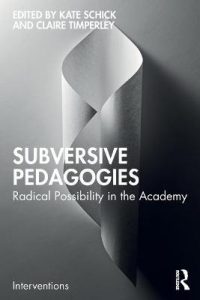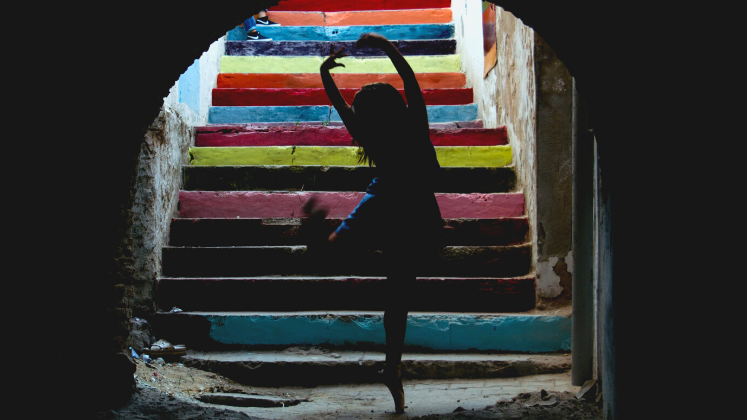In Subversive Pedagogies: Radical Possibility in the Academy, Kate Schick and Claire Timperley bring together contributors to explore teaching as a subversive space of radical possibility, drawing attention to pedagogies that are situated, embodied, caring and decidedly political. Judith Leijdekkers and Sander Hölsgens offer a conversation around the book, reading the collection as an invitation for fellow pedagogues to scrutinise, transform and resist the ready-made roles of teachers.
Subversive Pedagogies: Radical Possibility in the Academy. Kate Schick and Claire Timperley (eds). Routledge. 2021.
 Subversive Pedagogies opens with a call to action. It is an invitation to collectively carve out ‘generative and fulfilling spaces’ for learning – offering ‘alternatives to the narrow and exhausting scripts that structure our teaching’ (1). The collected volume acknowledges that COVID-19 laid bare the kinds of challenges the academy has been facing for multiple decades. Subversive Pedagogies is edited by critical theorists and pedagogues Kate Schick and Claire Timperley.
Subversive Pedagogies opens with a call to action. It is an invitation to collectively carve out ‘generative and fulfilling spaces’ for learning – offering ‘alternatives to the narrow and exhausting scripts that structure our teaching’ (1). The collected volume acknowledges that COVID-19 laid bare the kinds of challenges the academy has been facing for multiple decades. Subversive Pedagogies is edited by critical theorists and pedagogues Kate Schick and Claire Timperley.
The volume brings together pedagogues, teachers and educators who all address ‘the gaps and fissures of existing constraints in the neoliberal colonial academy’ (2). The eleven chapters help readers to orient themselves in their own efforts to radically address ‘what we teach, how we teach, where we teach, and who we teach’ (2). Positioning teaching as a subversive act towards transformation and possibility, the contributors draw attention to the kinds of pedagogies that are situated, embodied, caring and decidedly political.
We, Judith and Sander, read Subversive Pedagogies as an invitation for fellow pedagogues to scrutinise, move into and resist the ready-made roles of teachers. Echoing the volume’s dialogical and interrogatory inflection, we’ve decided to review it by way of a conversation. This helps us situate and contextualise the contours of our response, as much as it allows us to do justice to the aspirations and tone of the volume. Judith is a designer and educator. After teaching social work at a vocational school (‘mbo’), she now works as a gardening and art teacher at an elementary school. Sander is a visual anthropologist. He teaches at both a research university and applied college (‘hbo’). Sander and Judith both live in Charlois, Rotterdam.

Image Credit: Photo by Bermix Studio on Unsplash
Sander: You embrace education as a situated practice. The contributors of this collected volume work in a similar vein. Karyn Paringatai and Marcelle Wharerau, for instance, examine how specific Māori pedagogies are implemented in universities in New Zealand (Chapter Two). Naeem Inayatullah looks at ‘each moment – moments in which I wait for something to emerge’ (Chapter Four). And Ajay Parasram draws attention to the act of teaching development activism on stolen territory (Chapter Eight).
What stands out to you? And how do you as an educator relate to these subversive pedagogies?
Judith: I was drawn to parts of the book where the authors describe specific practices or experiences – the parts that reveal a connection with pedagogy, place and space. The part that has been on my mind for a few weeks is about teaching in the dark (Chapter Two). Karyn and Marcelle write that ‘the whare wānanga (pre-European institutions of learning of esoteric knowledge and occult lore) largely operated during the winter months, therefore teaching naturally extended into the night time’ (41). As the university is closed at night, it’s not easy to make space for teaching in the dark, and with that for Māori ways of learning and knowing.
But the teaching room described in this chapter is located in a former archive library and does not have any windows. ‘The sheer act of turning the lights off is a disruption to more conventional methods of teaching haka (chants) and waiata (songs).’ In the darkness, the students have to rely on their ears. They can only learn by listening, which comes with a collective responsibility. ‘Unlike Western values of education that place more emphasis on the student as an individual, my students realise the value of working collectively and are reliant on others to be focused on the same objective’ (51). Teaching in the dark shows the importance of being situated as an educator, both in a physical space and in a context with specific histories and ways of knowing.
As we talked about the book while reading it, I know teaching in the dark stood out to you as well. Could you explain why? In what way does it help you reflect on your own teaching?
Sander: First, because it points towards education as a situated practice – as you point out as well. But second, because it highlights how subversive pedagogies like these can challenge the neoliberal impulses to disembody the process of learning. The collected volume, and this chapter in the specific, shows that education covers so much more than knowledge production and transfer. While lots of teachers and students acknowledge this, the academy is not necessarily set up to embrace that the classroom might still be the most radical space of possibility – to paraphrase bell hooks.
Subversive Pedagogies takes this as its starting point. See, for instance, Claire Timperley’s chapter on embodiment and pedagogy. She opens her chapter (Six) by disclosing her cancer diagnosis, asking how this might affect her students, colleagues and readers: ‘Is this something that I should share with strangers? What are the implications of doing so? How might this information change the way my chapter is read and understood?’ (108). Timperley goes on by explaining that her body shapes who she is, how she teaches, how she is perceived and what she might take for granted. It is, in short, a plea for taking our embodied selves more seriously, both in the classroom and beyond.
What I take from this chapter is a heightened awareness of the range of sensory and embodied experiences that make up the classroom: from the fatigued soul to a body that cannot sit still in a room for eight hours. I teach anthropology students how to make films. Embodiment plays a central role within this kind of film training. But, historically, courses and degrees in ethnographic filmmaking assume one body type, one learning experience, one subjectivity. There’s increasing attention to postcolonial thought, but not to the varying demands and stresses that students might experience. Such norms not only determine what kind of films we expect students to make, but also discourage students (and lecturers!) from attuning to their own and their peers’ embodied experiences – and, by extension, their histories, politics, sensibilities. So, while multiple disciplines have gone through the sensory and affective turn, Timperley’s attunement to the lived experiences that make up the classroom can still be considered subversive.
This also brings me to the volume’s title: Subversive Pedagogies. What exactly do you think is subversive about these approaches to education? Do you think that the volume itself is subversive as well?
Judith: To me, situated and embodied pedagogies are both practices of care. By acknowledging different bodies, histories, narratives and perspectives, we take care of each other. It is subversive, because it steps away from the neoliberal idea of individualism and productivity. I know that many educators – especially in higher education – see how the number of students in classes increases, while the paid hours stay the same. There is less time to prepare and to support students, which directly influences our teaching. The pedagogies described in the book are making space for solidarity and collectivity. That is a subversive act, especially in the context of neoliberal and colonial universities.
Your question about the volume as a whole brought me to another question: what does subversive mean when it comes to academic writing? The educational diaries by Ajay Parasram (Chapter Eight) are a valuable example. The diaries give insight into Ajay’s teaching, including doubts and insecurities: ‘This class is nuts. I’m pretty sure 30% of these students hate everything that I’m saying, and probably a good 10% are pro-colonisation. Do they know I’m not a real development professor? What’s a real development professor anyway?’ (58).
While I am quite sure that every educator often has doubts about their own role and actions, it is not the norm in academic writing to discuss one’s fears, emotions or insecurities. Sharing a diary in an academic publication is – without a doubt – subversive.
The volume as a whole helped me reflect on how we put our teaching experiences and practices into words. Therefore, I’d like to conclude with a question: how can writing itself be a subversive act?
Sander: Blending personal and academic writing styles to reflect on one’s own subject position is most definitely one way, as Parasram’s chapter shows. But there’s more to it, as editors Schick and Timperley write in the introduction: ‘subversive: to exist in unexpected places and spaces; to take multiple and diverse forms; and to have greater capacity and reach than is often assumed’ (4). This all applies to the collected volume: Subversive Pedagogies interrogates dominant educational frameworks and academic power structures, through formal tactics, situated critiques and emancipatory practices. It’s a timely and generative contribution to the kind of pedagogical thought responding to our burning world.
Note: This review gives the views of the authors, and not the position of the LSE Review of Books blog, or of the London School of Economics and Political Science.
Banner Image Credit: Photo by Thomas Renaud on Unsplash.







